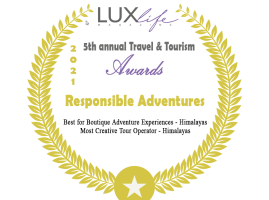Bhutan, the People, Culture and Religion
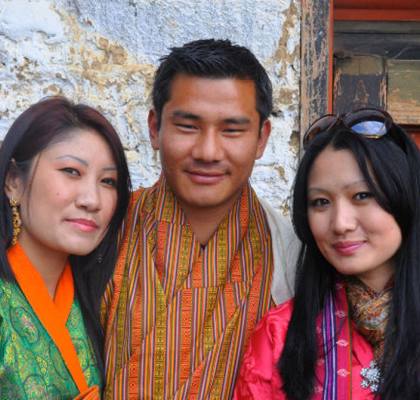
Bhutan, the People, Culture and Religion Bhutan had remained cut off from the outside world due to its remarkable geographical location. Part of this isolation was self-formed to protect its civilizations, unique identity, and independence from the rest of the world. The nation was observing strict segregation that tourism allowed foreigners to enter Bhutan from 1974. The Bhutanese mostly speak Dzongkha, Sharcop, the leading local languages, and Nepalese. The first two languages are linked to the Tibetan language, and the monks use the Tibetan scripture and language called Chokkey. The Bhutanese are similar to Tibetans and share distinct similarities in their arts, crafts, jewellery, and handicrafts. The Bhutanese and Tibetans both worship and revere Guru Padmasambhava or Guru Rimpoche. He was the tantric sage who introduced Buddhism into Tibet, which later followed into Bhutan. However, Bhutan’s people, culture, religious practices, and traditions have several distinct features. People of Bhutan According to a recent report in March 2017, Bhutan’s population is 789936 based on the United Nations estimate. They make up a mere 0.01% of the world population. Bhutan ranks 164 on the population list in the world. An estimated 40% of the population lives in the urban area, and the average age is pretty low at 27 years. Bhutan is sparsely populated in the mountainous and severely cold regions of the higher Himalayas and the arid tracts on the southern border with India’s Duars plains. The most populated areas of Bhutan are the fertile regions with the temperate climate of Central, Western, and South West (near the Indian border) The most populated Dzongkhags (administrative districts) are Thimpu, Chuka, Sarpang, Paro, and Phuentsoling, while Gasa remains one of the least populated Dzongkhags. Except for a few fixed roles based on gender, equality between females and males exists in traditional Bhutanese society. An excellent example of a selected function would be a man who works as a cloth maker while the woman is a weaver. Interestingly, both men and women work in villages, while in cities and towns, the man is the breadwinner while the woman is a homemaker. Arranged marriages do take place, but young couples choose their partners. Unions can be registered officially and sometimes involuntarily when the team has lived together for more than six months. Divorce isn’t uncommon at all; neither is it considered taboo. Both the government and the people of Bhutan give priority to education. It is accessible in Government schools until the higher secondary level, where students receive partial or complete scholarships depending on their merits. Once again, there is no disparity between the genders in education. The Bhutanese are a matriarchal society; the groom moves into the bride’s home after marriage. However, these days, most couples prefer to live separately on their own. Bhutan is a rare South Asian country that doesn’t practise the dowry system; the youngest daughter inherits her parental property (matrilineal). Women are not obligated to take on their father or husband’s name. Women also have no obligation to take on their father or husband’s name. As a result, polygamy and Polyandry are not uncommon. You will find many people with the same combination due to a limited selection of names in Bhutan. Sometimes they even use the name of their locality, village, or even their house for identification. There are fixed prayers and meal routines, and people observe the timings strictly. For example, the immigration off closes for thirty minutes precisely for lunch. Workingmen and women in offices or shops settle down to have their staple meal of ema datsi or rice around 2 pm. The honesty of the Bhutanese is what fascinates visitors to his nation. There have been cases where people got the shop owners have returned their lost belongings or extra money visitors paid. The Bhutanese are courteous to all visitors, no matter where they come from. Behavioural Code of Bhutan The Driglam Namzha is a formalized national dress and behavioural code. This code explains how the citizens of Bhutan have to dress and behave in public places. Driglam means discipline, regimentation, order, and custom, while Namzha means the system. The composite term implies The rule of regulation in behaviour. All citizens of Bhutan have been supposed to follow the Driglam Namzha since 1990. Cleanliness is taken very seriously by the Bhutanese Government, and they have initiated a series of rules and regulations to uphold the value of cleanliness and orderliness in the country. However, one can see the stark difference between the Bhutanese and Indian administrative systems in the border town of Phuentsoling and Jaigaon. The noisy, dirty ambience of the Indian border town of Jaigaon is a sharp contrast to the clean and orderly city of Phuentsoling in Bhutan. Some signages encourage the practice of cleanliness in every central public place, including roads and areas of interest. Streets are regularly swept, and public toilets and all tourist places of interest are kept clean by the government. Dress Code Bhutanese men dress up in a knee-length robe that is tied at the waist with a belt. This dress is called Gho, whereas the women wear colourful blouses with a large rectangular cloth tied at Kira’s waist. In addition, the women often wear a bright brocade jacket over the blouse. All Bhutanese follow this dress code for official visits, occasions, public ceremonies, and festivals. Religion Buddhism is the principal religion of Bhutan, and it reflects clearly in all domains of life there. Household items and utensils have religious symbols; prayer flags fluttered on hills, roads, bridges, and trees. Religion here is a way of life that surrounds their lives. You will observe that almost all roofs have a slight white prayer flag fluttering on top. This indicates that the owner has offered to the local deity for appeasement. Each district of Bhutan is known as a Dzongkhag, consisting of a Dzong (Fort) with massive walls that serve as a religious and administrative hub. Apart from a monastery and prayer hall, these Dzongs have chambers of justice,
The best treks in Ladakh
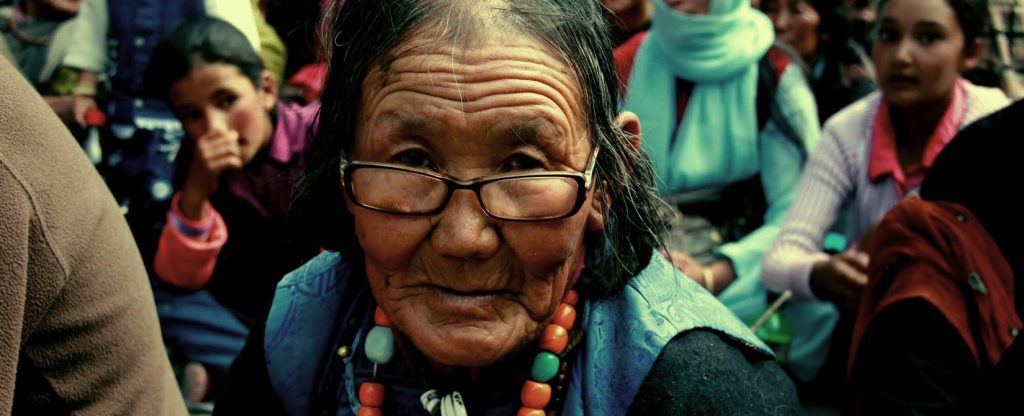
The Best treks in Ladakh The best treks to participate in Ladakh include an option for people of all fitness levels and experiences. There are many trekking companies, both local, regional, and international, that offer trekking vacations. These companies will organize the guide, and support crew, provide necessary trekking equipment, and pack animals and meals. Recently it has been possible to go trekking and stay in simple homestays with the villagers. You will find that there is a considerable variation in cost between the trekking agencies. However, this gives you an idea of what you can expect in the quality of services, equipment, and food and will make a massive difference in your experience. You will find the most popular Markha Valley Trek online and the ever-growing companies in Leh’s main bazaar. However, don’t be fooled into thinking everyone can do this trek; it isn’t an easy trek. It involves crossing at least one if not two high passes around 5000 meters in altitude. You will sleep at a high altitude for several nights on this trek. This famous trek brings you an outstanding combination of Ladakhi lifestyles and culture with stark landscapes, unusual rock formations, and canyons. The Markha Valley trek is between the Stok and Zanskar ranges, south of Leh. The starting point can vary with the number of days you have for this trek, as road construction has opened up the options. Zingchen is the entrance to Hemis National Park, where a fee is charged. It is one of the largest National parks in India and the only one North of the Himalayas. You can go on a camping trek or stay at village homestays. A camping trek is a private “luxurious” version (depending on the company you have booked), and the homestays can be overbooked as the phones might be out of order. If a homestay is fully booked, you might be able to spend the night in local teahouses or parachute cafes; make sure you have a perfect sleeping bag. The parachutes are used to airdrop food supplies to the troops by the army. Duration: 6-12 days. Level: Moderate to strenuous Hours of Trekking Per Day: 4-6 hours most days, with some days 8-10 hours towards the end. Highlights: Panoramic vistas from high-altitude passes. Ruined Forts at Markha and Hankar. A visit to Hemis monastery at the end of the trek. When to Go: Mid-June to late September. Sham Trek (Likir-Temisgam): For Beginners The Ladakhis call this the “baby trek,” but you have to remember that it goes over 4000 meters over more minor passes, and the daytime temperatures can be hot during the summer. This is the most popular trek in Ladakh and is suitable for beginners. However, it does have its challenges with some steep climbs and descents. You will be going through villages in the arid Sham region in Ladakh. You will get to Likir at a ninety-minute drive from Leh. This trek is ideal who want to try a shorter duration trek, beginners, and families. It is a lower altitude trek than the other areas where you mostly sleep below 4000 meters, and the passes are relatively shorter in the distance. Lately, homestay accommodation has been mushrooming. It is possible to do this trek without packing animals; you can have a support vehicle to carry your duffel bags and meet you at the homestay at the end of the day. Duration: 4 – 5 days. Level: Moderate. Hours of Trekking Per Day: 4-5 hours. Highlights: Rugged and frequently changing landscape, plus monasteries at Likir and Ridzong. When to Go: Anytime from late May to late September (it will be hot during July and August). Lamayuru-Alchi: Ancient Monasteries Trail Four of the oldest surviving monasteries in Ladakh lie on this route, which is more robust than the Markha Valley Trek. It is a superb opportunity to combine the trek with the historical heritage of this region. It begins from Lamayuru, which is about three hour’s drive from Leh on the Srinagar-Leh highway. This famous village is the starting point for many treks in Ladakh. There are several guest houses in the town. Lamayuru monastery is beautifully perched above the camping ground. This trek is challenging in parts, but the Zanskar range’s clear sparkling streams make it worthwhile. Duration: 5-6 days. Level: Moderate to strenuous. Hours of Trekking Per Day: 5-6 hours each Highlights: Lamayuru Monastery, the oldest monastery in Ladakh, dates back to the 11the century and is where the mystic Naropa meditated in a cave. Alchi Monastery is celebrated for its impressive early Kashmiri Buddhist murals. When to Go: Mid-June to late September. Rumtse-Tsomoriri trek This trek takes you to the remote area of Changthang – a continuation of the Tibetan plateau. You will be trekking in a high-altitude area home to the Nomads. It also becomes the summer breeding ground for many rare and endangered birds. Duration: 9 days. Level: Strenuous. Hours of Trekking Per Day: 6-7 hours. Highlights: Rich in Flora and fauna in Hemis National Park. We visited Stok Palace at the end of the trek. When to Go: Mid-June to late September. Padum-Darcha: Remote Wonders Despite being a long trek from Zanskar in Ladakh to Lahaul in Himachal Pradesh, it is an ideal trans Himalayan trek for the first-time trekker, with only one pass above 5000 meters. It starts at Padum; two days drive from Leh, there are plenty of campsites, and homestays are growing annually. Then, you will trek towards the Lugnak Valley, southeast of Zanskar, an old trading route between Zanskar and Lahaul. If you like a longer and more challenging trek, you can combine the Lamayuru with the Padum trek. It will become a three-week-long adventure. It is best to do this trek soon as a road is being built between Padum and Darcha. Duration: 9 days. Level: Easy to moderate. Hours of Trekking Per Day: 5-8 hours Highlights: Phuktal monastery is a mind-blowing monastery. This isolated location of Phuktal is only reachable by trekking. When to Go: June to September. Zanskar Chadar Trek: Walking on Ice When snowfall starts covering
Ayurvedic food for a satisfying diet
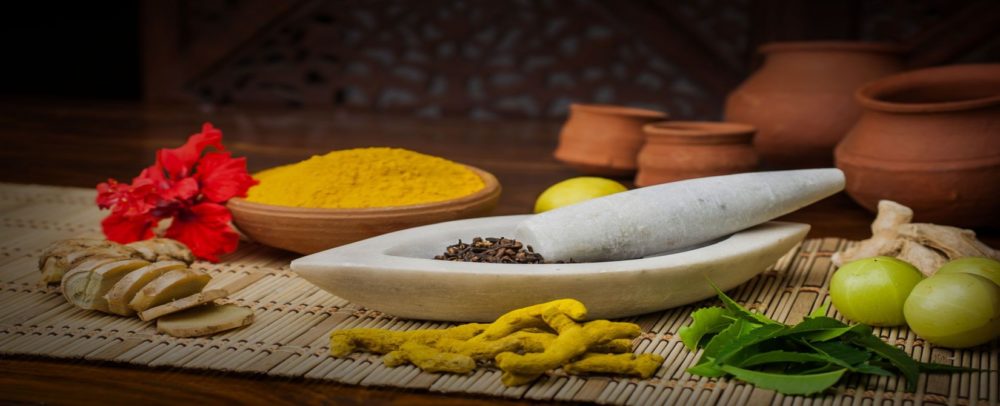
Ayurvedic food for a satisfactory diet Ayurveda’s Satisfaction Diet Ayurveda, Uncategorized, Wellness / By Dr Harrison Graves, MD Feel Better Today: Add More Tastes Have you ever eaten to the bottom of a bag of salt and vinegar potato chips only to find yourself unsatisfied? Have you ever dug into a pint of Ben and Jerry’s, only to find yourself craving something that’s missing? Welcome to the American diet. We attempt to use food, especially sweet and salty food, to find comfort in our country, yet find true satisfaction lacking. Ayurveda, the “Science of Life,” tells us that salt and sugar are only two of the six tastes the body needs to maintain optimum health and feel truly satisfied after meals. Ayurveda holds six tastes: sweet, sour, salty, bitter, spicy, and astringent. For optimum health, we need to taste them all every day. Each one has a specific energetic effect on the body. They can warm us up or cool us down. They can make us feel complacent or motivated. Taken together, the six tastes can lead the body and mind into perfect balance and create a sense of absolute satisfaction. Sweet and salty may work well to instantly alleviate the anxiety (excess Vata) that comes with 24/7 multitasking. However, eating only these tastes and poor quality, to boot — has dire consequences for physical and mental health. Mixing It Up Getting all six tastes does not mean creating equality in volume: a little salt goes a long way. Nor does it mean having a six-course meal at every sitting. “Keep it simple,” recommends Patti Garland, a master Ayurvedic chef and owner of Bliss Kitchen in Palm Desert, California. “Eat leafy green vegetables every day, and drink a lassi. Play around with spices — turmeric, cumin, coriander, and fennel will expand your palate instantly. Add quick-cooking lentils, split mung beans, or red lentils to your diet. Have a whole grain. Put it all together in a bowl, or serve it in individual dishes in one sitting or over a day. Try to have your big meal at lunch when digestion is strongest.” Curry and rice is a favourite dish served at our dining hall. Moreover, whatever you are eating, pay attention. If you are craving food, ask yourself what it is you want. Craving can come out of habit or tell you about something your body needs — which may not be food. For example, you could be craving love and connection. Once you find a bit of balance, your intuition will guide you to the right choices. Ayurveda is about conscious eating and pure satisfaction. Stress and Craving: The Vicious Cycle The entire American food industry has developed to serve and reinforce our cravings. They serve up sweet, sour, and salty and give it to us fast so we can return to doing whatever it was that created our imbalance. Then we get stressed and eat more sweet, sour, and salty. Such foods calm us, yes, but they make us feel heavy, tired, and depressed when we overdose. “Our culture is consumed with the disease of overnutrition: high blood pressure, diabetes, and obesity,” observes Thomas Yarema, MD, integrative physician and author of Eat-Taste-Heal. “We keep developing diet plans to deal with these problems,” says Yarema, “yet our success rates with heart disease and diabetes have been poor. Moreover, most of the diets we concoct to address the obesity problem — from low-fat to low-carb to grapefruit-only diets — fail in the end. As a result, we are confused about nutrition in modern times.” Yarema offers this easy way to understand dosha dynamics: “The tastes of sweet, sour, and salty convert energy into matter,” he says. “Bitter, pungent, and astringent turn matter into energy. The diseases in Western culture all have to do with a deficiency in energy and an excess of matter (bodyweight).” What is the cure, then, for what ails us? Where is a satisfaction to be found? First, balance the diet with more bitter, pungent, and astringent foods. Eating for Fulfillment In Ayurveda, when and where eating counts nearly as much as the what. Pay attention to the environment surrounding your food; you will be less likely to make poor choices or eat unconsciously. Here are some expert tips for eating in balance: Focus on the Food. “If you feel stressed, you might decide getting things done is more important than taking time for meals,” says Scott Blossom, yoga therapist and Ayurvedic practitioner. “But eating while multitasking only aggravates stress and imbalance.” Say, Grace. “For your body to taste the food, it has to know it is going to eat,” says Suhas Kshirsagar, director of the Kerala Ayurveda Academy. “Sit down; close your eyes before your meal; give thanks for your food. It is not just a religious tradition but a physiological one.” Then, empower your food with healing mantras (like Om Namah Shivaya) by chanting during food preparation and before eating. Adjust for Weather. You may notice that a hot, spicy soup tastes much better in winter than on a hot July day. If it is freezing outside, focus on warming foods. Cold drinks in the winter will inhibit your digestive fire. Mary Roberson, PhD, founder of the Ayurvedic Center for Healthcare in Oak Ridge, Tennessee, says, “You can use common sense, as informed by Ayurvedic theory, to bring yourself into harmony with your environment.” Rest and Digest Ayurveda suggests eating a more substantial meal with all six tastes between 10 a.m. and 2 p.m. A gentle walk after your dinner and a 10- to 15-minute rest gives the body a chance to digest. Guests were walking on a nature trail on campus. This article originally appeared on the Art of Living Retreat Center’s Website. Check out our Trekking packages for Nepal, Bhutan, India, and Tibet.
Trekking in Nepal during November
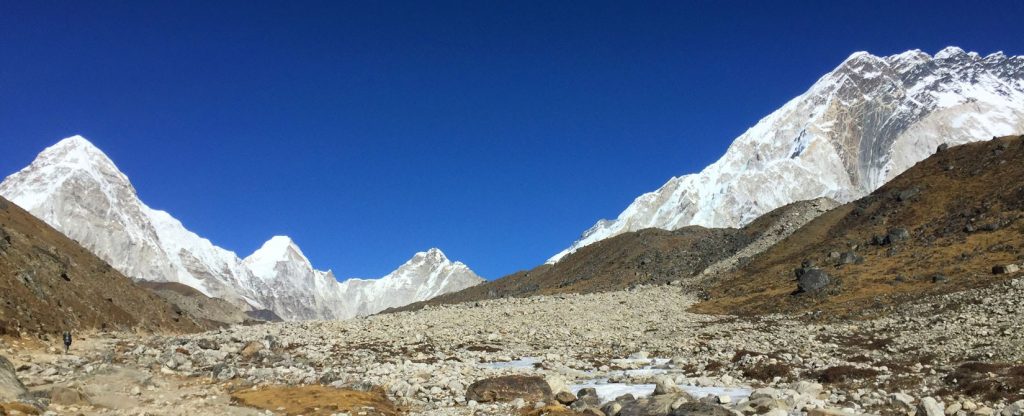
Trekking in Nepal in November November is a much better month to go trekking in Nepal. This is because the monsoon should be long gone by November. However, there is rainfall for a couple of days every month, both post and pre-monsoon, and sometimes freak weather occurs every few years. The daytime temperatures are warm below 1500 meters, cool up to 2500 meters, and warm/cool above 2500 meters. Therefore, you can do most treks during November. This is ideal for regular treks such as Annapurna Circuit with Tilicho Lake, Everest base camp, Mardi Himal, Annapurna Base Camp, and Upper Mustang. It pays to invest in the right equipment, such as a suitable down jacket, sleeping bag, a couple of layers of fleece, the right thermal underwear, thick hiking socks, gloves, trekking pants, warm hats, and essential gears. It is always better to have more than less. It is good to dress up in layers, which you can ‘peel’ one at a time when you start to warm/heat up as you begin trekking. You can hike in shorts in the lower to middle altitude areas. Benefits of Trekking in Nepal Himalaya during November. This is the fall season; some flowers are still blooming in the middle of Nepal. The clouds can begin to form during the late afternoon. However, the colder weather should make the clouds stay low longer and descend quicker in the late afternoons. The trekkers will be seen in significant numbers on the trail and in the lodges during November. You will be warm to hot while hiking during the daytime. You will meet plenty of other trekkers on the trail and lodges. You can socialize with a lot of people. The views should be fantastic for most of the day. Can I do a high-altitude trek in Nepal in November? You can undoubtedly do a high-altitude trek in Nepal during November. This is a better time to do a high-altitude hike than in February or March. However, you can expect some snowfall in the higher elevations, but this should melt quickly due to the warmth and humidity. We do receive some precipitation for a few days every month. We receive more massive snowfalls during February and March rather than in the middle of November. Dangers/Inconveniences of trekking in Nepal during November. There can be a few days of rain in the lower elevations while snowfall on the higher grounds. If you come across a landslide area, do the following: Landslides can be dangerous; walk briskly with utmost caution when you cross landslide areas on the trail. DO NOT stop to take photos in the middle of the landslip area. Instead, two or more of you cross the landslide area while the other person looks out for falling rocks. Lodges can be full of trekkers, even sleeping on the dining tables, benches, and floors. There have been times when trekkers had to walk for two to three hours more than intended/planned, as all the lodges were full. The WIFI speed could be frustratingly slow due to the number of users. You can use the Internet (if it is not too slow) for weather forecasts and temperatures. There could be a lot of people queuing for hot showers. You might find the lodges are full and might have to walk to the next village to find a room in a hostel. The lodge owners prefer two persons to share a room as they make more money from the food they sell. The rush of Deepavali celebrations can make it difficult to get bus and flight tickets at the last minute. Fog can delay and disrupt domestic flights in Kathmandu and Pokhara. November 2020 – The weather was excellent this year, with clear days most of the month apart from the usual 3-5 days of monthly rain/snowfall, depending on the altitude. November 2019 – The temperatures followed the previous year with colder temperatures with some cloudy days and some days of precipitation. November 2018 – The temperatures have been colder than usual this autumn season. This year the weather was cloudy in the early morning during the first two weeks. The views were excellent in the early mornings in the middle altitude, but the mountains got covered quite early – sometimes as soon as 7 am. Some rainfall took place on different days in different parts of the country. The weather improved and stayed clear for most of the day during the last week of the month. Check out our Trekking packages for Nepal, Bhutan, India, and Tibet.
Trekking in Nepal during October
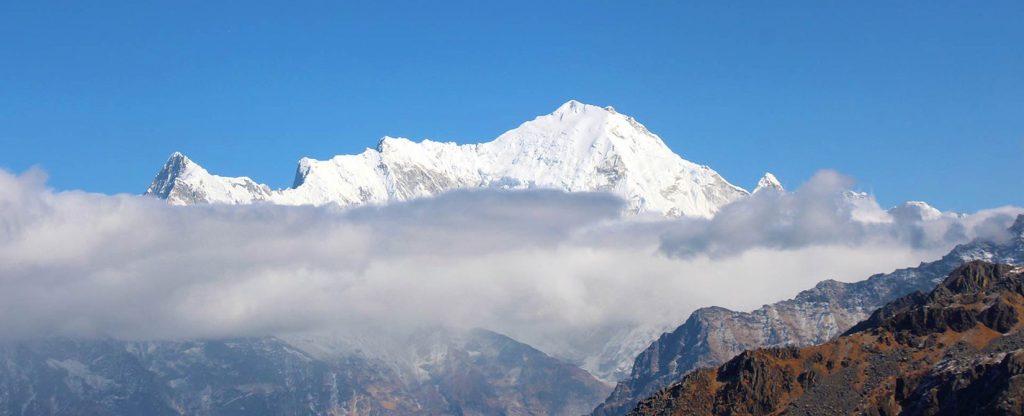
Trekking in Nepal in October Most tour operators claim October to be the best month for trekking in Nepal. This statistic was accurate 25 to 30 years ago. These days the monsoon can linger around longer. Cyclones could disturb the weather in the Bay of Bengal, sometimes resulting in unseasonal snowfall, which has proven fatal. The most recent tragedy occurred in October 2014, caused by Cyclone Hud Hud. The daytime temperatures are warm to hot below 1500 meters, up to 2500 meters, and warm/cool above 2500 meters. Therefore, you can do most treks during October, and it is advised to choose higher altitude treks for cooler temperatures. This is an ideal time to do regular treks such as Annapurna Circuit with Tilicho Lake, Everest base camp, Mardi Himal, Annapurna Base Camp, or go for more adventurous walks such as The Upper Dolpo Circuit or Upper Dolpo Traverse or Upper Mustang as these regions are in the rain shadow. It pays to invest in the right equipment such as a suitable raincoat or even an umbrella, sleeping bag, a couple of fleece layers, right thermal underwear, thick hiking socks, gloves, trekking pants, and warm hats name a few essential gears. It is always better to have more than less. It is good to dress up in layers, which you can ‘peel’ one at a time when you start to warm/heat up as you begin trekking. You can hike in shorts in the lower to middle altitude areas. Benefits of Trekking in Nepal Himalaya during October. This is the fall season; some flowers are still blooming in Nepal’s middle and high hills. However, the clouds can begin to form during the late afternoon, and it can start raining at the lower altitude and snow in the higher elevations during the late afternoons. This could be a good thing to clear the clouds and clear the clouds for excellent mountain views the following day. The trekkers will be seen in significant numbers on the trail and in the lodges during October. You will be warm to hot while hiking during the daytime. You will meet plenty of other trekkers on the trail and lodges. You can use the Internet (if it is not too slow) for weather forecasts and temperatures. A lot of people could be queuing for hot showers. You can see villages ripening crops such as rice and millet. Can I do a high-altitude trek in Nepal in October? You can undoubtedly do a high-altitude trek in Nepal during October. This is a better time to do a high-altitude tour than in February or March. However, you can expect some snowfall in the higher elevations, but this should melt quickly due to the warmth and humidity. We do receive some precipitation for a few days every month. We receive more massive snowfalls during February and March rather than in the middle of October. Dangers/Inconveniences of trekking in Nepal during October. Trekking trails can still be muddy and slippery. Be careful of wet roots while trekking through forests. Again, leeches might come out when it rains, in moist areas in early October, or when it rains. For prevention, you can make a small pouch of rock salt and chewing tobacco. You can dab the bag on the leeches when they get on your boots, clothes, or you. You need to dip the bag in water to moisten it is more useful this way. Some people burn the leeches or use Dettol or regular salt. However, the rain can wash them off, making rock salts and chewing tobacco mixture an excellent choice. Landslides can be dangerous; walk briskly with utmost caution when you cross landslide areas on the trail. DO NOT stop to take photos in the middle of the landslip area. Instead, two or more of you cross the landslide area while the other person looks out for falling rocks. Start early in the morning to avoid the afternoon rains. There usually is a pattern when it starts to rain. Study it for a couple of days or speak to the lodge owners. The WIFI speed could be frustratingly slow due to the number of users. Lodges can be full of trekkers, even sleeping on the dining tables, benches, and floors. There have been times when trekkers had to walk for two to three hours more than intended/planned, as all the lodges were full. The leeches start coming out in elevations below 2400 meters when it rains. The mountains remain clear only during the mornings mostly. It can be hot and humid in lower elevation areas. Insects in the lower altitude areas can bite you – bring along the proper insecticide. October is autumn; However, rains could disrupt domestic flights to or from Short take-off and landing strips (STOL) airports like Lukla, Jomsom, and Juphal. Landslides can block roads causing delays in your holiday program. Foggy weather in the valleys of Kathmandu and Pokhara can delay flights. There is a massive exodus of migrant workers from Kathmandu during the Hindu Festival of Dashain (it can be next to impossible to get bus seats and when you are close to the main festival days, even on domestic flights. October 2021 We experienced heavy rainfall in the first week. After that, we had continuous rain from the 17th to the 20th of October, which caused landslides and floods in the nation. The precipitation was caused by the combined influence of two weather systems that developed a week after the exit of the monsoon. As a result, the eastern and far-western regions of the country were severely affected by the torrential rains. October 2020 – The monsoon rains receded from the second week on schedule. October 2019 The monsoon rains lingered much longer this year. It affected the flights to Lukla and Jomsom until the second week of the month. In the Everest region, there was unseasonal rain/snowfall. October 2018 The first week of October experienced clear weather in the mornings, but the clouds
Trekking in Nepal during September
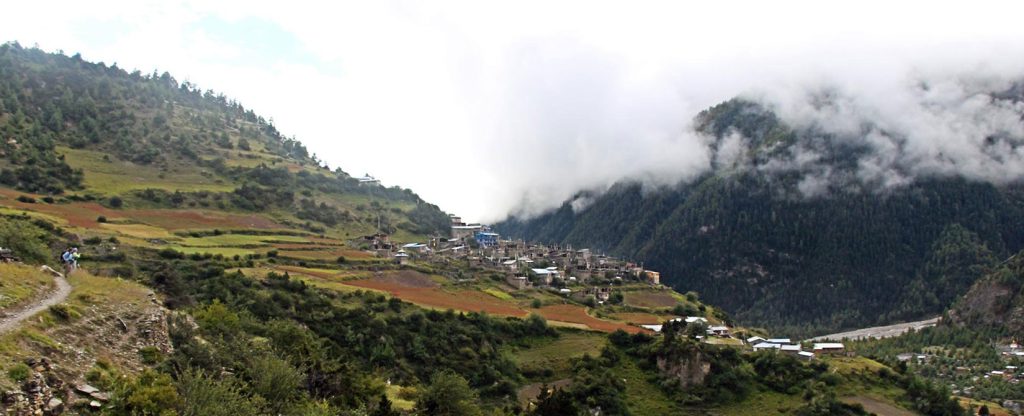
Trekking in Nepal during September For most trekking tour operators, the month of September is the beginning of the autumn trekking season. However, it is the tail end of the monsoon season, and it can rain until the third week, and occasionally it rains until the end of the month. The daytime temperatures are to be warm to hot and humid below 1500 meters, warm up to 2500 meters, and warm/cool above 2500 meters. Therefore, you can do most treks during September, and it is advised to choose higher altitude treks for cooler temperatures. This is an ideal time to do regular treks such as Annapurna Circuit with Tilicho Lake, Everest base camp, Mardi Himal, Annapurna Base Camp, or go for more adventurous walks such as The Upper Dolpo Circuit or Upper Dolpo Traverse or Upper Mustang as these regions are in the rain shadow. It pays to invest in the right equipment such as a suitable raincoat or even an umbrella, sleeping bag, a couple of fleece layers, right thermal underwear, thick hiking socks, gloves, trekking pants, and warm hats name a few necessary gears to invest in. It is always better to have more than less. It is good to dress up in layers, which you can ‘peel’ one at a time when you start to warm/heat up as you begin trekking. You can hike in shorts in the lower to middle altitude areas. Benefits of Trekking in Nepal Himalaya during September. This is the beginning of the fall season; some flowers are still blooming in Nepal’s middle and high hills. However, the clouds can begin to form during the early afternoon, and it can start raining at the lower altitude and snow in the higher elevations during the late afternoons. This could be a good thing to clear the clouds and clear the clouds for excellent mountain views the following day. You might even see a lot of substantial colourful moths during September while trekking in Nepal. The trekkers will start to be seen on the trail and in the lodges if you go trekking during September to the popular trekking areas where there are lodges. You will be warm to hot while hiking during the daytime. You will meet other trekkers on the trail and lodges. The WIFI speed should be decent as the fall season isn’t yet in full swing. You can use the internet for weather forecasts and temperatures. There will be fewer people queuing for hot showers. You can see villages ripening crops such as rice and millet. Can I do a high-altitude trek in Nepal during September? You can undoubtedly do a high-altitude trek in Nepal during September. This is a better time to do a high-altitude trek than February or March. However, you can expect some snowfall in the higher elevations, but this should melt quickly due to the warmth and humidity. We do receive some precipitation for a few days every month. We receive more massive snowfalls during February and March rather than in the middle of September. Dangers/Inconveniences of trekking in Nepal during September. Trekking trails can still be muddy and slippery. Be careful of wet roots while trekking through forests. Leeches might again come out when it is raining or in moist areas. For prevention, you can make a small pouch of rock salt and chewing tobacco. You can dab the bag on the leeches when they get on your boots, clothes, or you. You need to dip the bag in water to moisten it is more useful this way. Some people burn leeches or use Dettol or regular salt. However, the rain can wash them off, making rock salts and chewing tobacco mixture an excellent choice. Landslides can be dangerous; walk briskly with utmost caution when you cross landslide areas on the trail. DO NOT stop to take photos in the middle of the landslip area. Instead, two or more of you cross the landslide area while the other person looks out for falling rocks. Thunder and Lightning storm It is not a regular occurrence, but occasionally there might be thunder and lightning storms. So in case, you are caught in the rain: Take refuge in a vehicle or grounded building when lightning and thunder begin. If you are far from a vehicle or a building, stay clear from tall objects like trees, electric/telephone poles, and bodies of water. Instead, find a depression or a low spot and make yourself as small as possible – DO NOT lie down on the ground. If you are a group, spread yourselves 50-100 feet away to avoid multiple victims, as lightning can travel along the ground. If you happen to be indoors, avoid taking showers or doing laundry and avoid charging your phone or other gadgets. Stay indoors for at least 30 minutes after the last seen lightning or since the last thunder. Start early in the morning to avoid the afternoon rains. There usually is a pattern when it starts to rain. Study it for a couple of days or speak to the lodge owners. The leeches start coming out in elevations below 2400 meters if it rains. It can be hot and humid in lower elevation areas. Insects in the lower altitude areas can bite you – bring suitable insecticide. September is the monsoon’s end; rains could disrupt domestic flights to or from Short take-off and landing strips (STOL) airports like Lukla, Jomsom, and Juphal. In addition, landslides can block roads causing delays in your holiday program. September 2021 – The disturbances in the Bay of Bengal cause heavier precipitation than usual. September 2020 – There was a lull in the monsoon rains in the first week while the second and thirds precipitation returned to ‘normal.’ September 2019 – The combination of heavy to moderate rainfall was experienced this month. September 2018 received a lot of rainfall during the first ten days; then, there was a lull in precipitation, which picked up again from the third week.
Trekking in Nepal during August
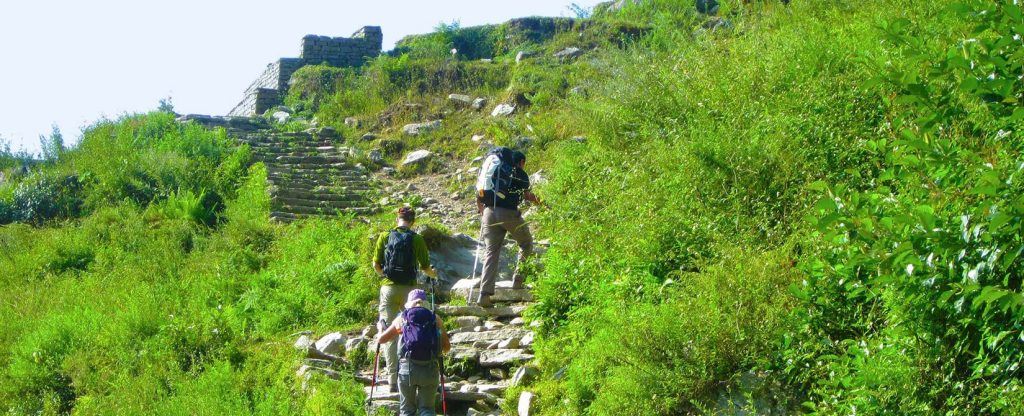
Trekking in Nepal in August The month of August is in the middle of the monsoon season. The daytime temperatures are hot and humid below 1500 meters, warm up to 2500 meters, and warm/cool above 2500 meters. You can do most treks during August, and it is advised to choose higher altitude treks for cooler temperatures. This is ideal for the Upper Dolpo Circuit, Upper Dolpo Traverse, or Upper Mustang, as these regions are in the rain shadow. It pays to invest in proper equipment such as a suitable raincoat or even an umbrella, sleeping bag, a couple of fleece layers, right thermal underwear, thick hiking socks, gloves, trekking pants, and warm hats. Here are a few essential gears to invest in. But, of course, it is always better to have more than less. It is good to dress up in layers, which you can ‘peel’ one at a time when you start to warm/heat up as you begin trekking. Benefits of Trekking in Nepal Himalaya during August. This is the monsoon season, and flowers bloom in Nepal’s middle and high hills. However, the clouds can begin to form in the early part of the day, and it can start raining at the lower altitude and snow in the higher elevations during the late afternoons. This could be a good thing to clear the clouds and clear the clouds for excellent mountain views the following day. You might even see a lot of giant colourful moths during August while trekking in Nepal. There will be fewer trekkers on the trail and in the lodges if you go trekking during August to the popular trekking areas where there are lodges. You will be warm to hot while hiking during the daytime. You could be the only trekker in the lodge. For the same reason, the wifi works better in the hostels as fewer people log in. You can use the internet better for weather forecasts and temperatures. There will be fewer people queuing for hot showers. The high-altitude flowers will be blooming at altitudes above 4500 meters. You can see villagers busy with agricultural activities. The plants, trees, and soil are fragrant with the monsoon rain. The sound of rain on the roof helps most people get a deep, sound sleep. Can I do a high-altitude trek in Nepal during August? You can undoubtedly do a high-altitude trek in Nepal during August. This is a better time to do a high-altitude trek than February or March. However, you can expect some snowfall in the higher elevations, but this should melt quickly due to the warmth and humidity. Nevertheless, we do receive some precipitation for a few days every month. Dangers/Inconveniences of trekking in Nepal during August. Trekking trails can be muddy and slippery. Be careful of wet roots while trekking through forests. Leeches can be a nuisance when it is raining or in moist areas. Landslides can be dangerous; walk briskly with utmost caution when you cross landslide areas on the trail. DO NOT stop to take photos in the middle of the landslip area. Instead, two or more of you cross the landslide area while the other person looks out for falling rocks. Leeches can be significantly irritating while trekking in Nepal during the monsoon. For prevention, you can make a small pouch of rock salt and chewing tobacco. You can dab the bag on the leeches when they get on your boots, clothes, or you. You need to dip the bag in water to moisten it more efficiently. Some people burn leeches or use Dettol or regular salt. However, the rain can wash them off, making rock salts and chewing tobacco mixture superior. Thunder and Lightning storm It is not a regular occurrence, but occasionally there might be thunder and lightning storms. In case you are caught in a rainstorm: Seek refuge in a vehicle or grounded building when lightning and thunder begin. If you are far from a vehicle or a building, stay clear from tall objects like trees, electric/telephone poles, and bodies of water. Instead, find a depression or a low spot and make yourself as small as possible – DO NOT lie down on the ground. If you are a group, spread yourselves 50-100 feet away to avoid multiple victims, as lightning can travel along the ground. If you happen to be indoors, avoid taking showers or doing laundry and avoid charging your phone or other gadgets. Stay indoors for at least 30 minutes after the last seen lightning or since the last thunder. Some lodges are shut, but you will find a comfortable place to spend the night. Not all food on the menu will be available. Start early in the morning to avoid the afternoon rains. There usually is a pattern when it starts to rain. Study it for a couple of days or speak to the lodge owners. The monsoon season has started, and it can rain while you are trekking (Normally, it starts to rain from 3 pm onwards; this isn’t a hard and fast rule). It can continue to rain for a few days occasionally. The leeches start coming out in elevations below 2400 meters if it rains. It can be hot and humid in lower elevation areas. Insects in the lower altitude areas can bite you – bring suitable insecticide. August is the monsoon’s middle; rains could disrupt domestic flights to or from Short take-off and landing strips (STOL) airports like Lukla, Jomsom, and Juphal. In addition, landslides can block roads causing delays in your holiday program. August 2021 – Normal monsoon rainfall took place. August 2020 experienced heavier rainfall compared to most recent years. Good monsoon rains for 2019 finally took place in August. The beginning of August 2018 is receiving pretty good rainfall. However, the rainfall slowed down during mid-July, and moderate-heavy rain occurred during the third and last week of August. Trekking regions that fall into the Rainshadow areas:
Trekking in Nepal during July
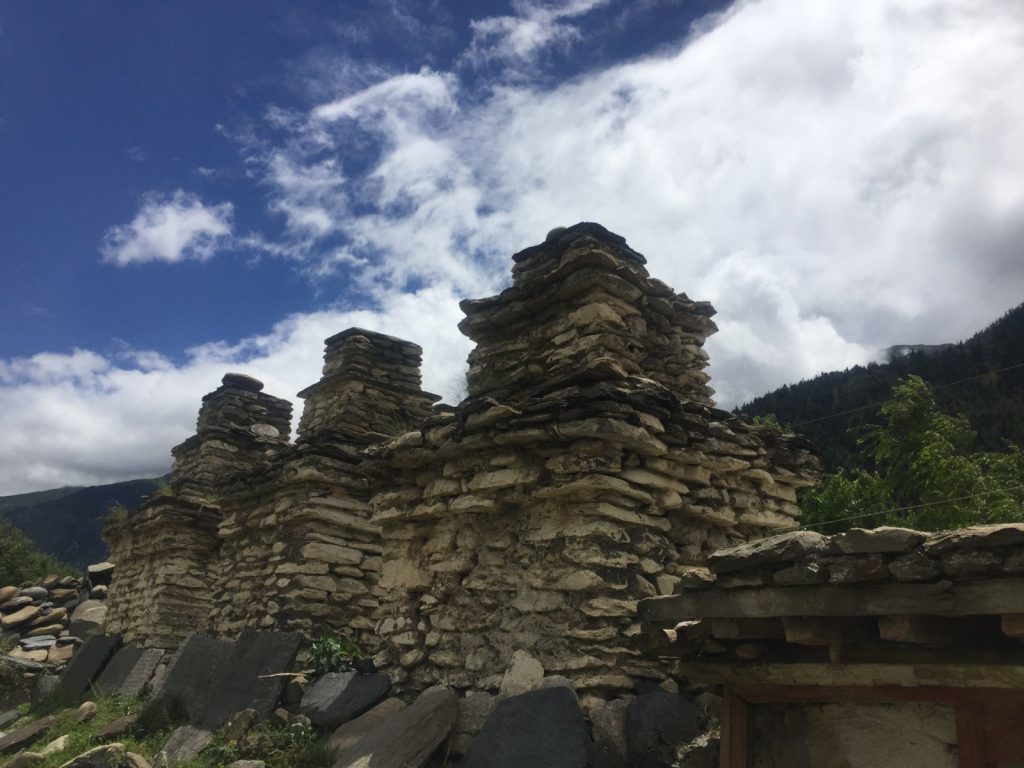
Trekking in Nepal in July In July, the monsoon season takes place. You can expect the daytime temperatures to be hot and humid below 1500 meters, warm up to 2500 meters, and warm/cool above 2500 meters. You can do most treks during July, and it is advised to choose higher altitude treks for cooler temperatures. This is an ideal time to do the Upper Dolpo Circuit, Upper Dolpo Traverse, or Upper Mustang, as these regions are in the rain shadow (you will have to book these treks with a trekking company; backpackers are not allowed into these regions). As always – it pays to invest in the right equipment such as a suitable raincoat or even an umbrella, inner liner, a couple of layers of fleece, the right thermal underwear, thick hiking socks, gloves, trekking pants, warm hats, to name a few essential gears to invest in. It is always better to have more than less. It is good to dress up in layers, which you can ‘peel’ one at a time when you start to warm/heat up as you begin trekking. Humidity makes it difficult for wet clothing to dry; bring a few sets to change into. Benefits of Trekking in Nepal Himalaya during July. This is the monsoon season, meaning many flowers and plants will bloom. However, the clouds can begin to form in the earlier part of the day, and it can start raining during the late afternoon or evening. This is a good thing as it can clear the clouds and clear the clouds for excellent mountain views the following day. In addition, there are colourful giant moths during this season. There will still be fewer trekkers on the trail and lodges if you go trekking during July to the popular trekking areas where there are lodges. You are pretty likely to be hot while hiking during the daytime. You might be the only trekker in the lodge. For the same reason, the wifi works better in the hostels as fewer people log in. You can use the Internet better for weather forecasts and temperatures. There will be fewer people queuing for hot showers. The flowers will be blooming at altitudes above 4500 meters. You can see villagers busy with agricultural activities. The plants, trees, and soil are fragrant with the monsoon rain. The sound of rain on the roof helps most people get a deep, sound sleep. Can I do a high-altitude trek in Nepal during July? You can undoubtedly do a high-altitude trek in Nepal during July. This is a better time to do a high-altitude trek than February or March. This is because we receive some monthly precipitation for a few days. We receive more snowfalls during February and March. Dangers/Inconveniences of trekking in Nepal during July. Trekking trails can be muddy and slippery. Be careful of slippery roots while trekking through forests. Leeches can be a nuisance when it is raining or in moist areas. Landslides can be dangerous; walk briskly with utmost caution when you cross landslide areas on the trail. DO NOT stop to take photos in the middle of the landslip area. Instead, two or more of you cross the landslide area while the other person looks out for falling rocks. Leeches are a nuisance while trekking in Nepal during the monsoon. For prevention, you can make a small pouch of rock salt and chewing tobacco. First, you can dab the bag on the leeches when they get on your boots, clothes, or you. Next, you need to dip the pouch in water to moisten it; it is more efficient. Some people burn leeches or use Dettol or regular salt. However, the rain can wash them off, making rock salts and chewing tobacco mixture a preferable choice. Thunder and Lightning storm It is not a regular occurrence, but occasionally there might be thunder and lightning storms. So in case, you are caught in the rain: Seek refuge in a vehicle or grounded building when lightning and thunder begin. If you are far from a car or a building, stay clear from tall objects like trees, electric/telephone poles, and bodies of water. Instead, find a depression or a low spot and make yourselves as small as possible – DO NOT lie down on the ground. If you are a group, spread yourselves 50-100 feet away to avoid multiple victims, as lightning can travel along the ground. If you happen to be indoors, avoid taking showers or doing laundry. Likewise, avoid charging your phone or other gadgets. Stay indoors for at least 30 minutes after the last seen lightning or since the last thunder. Some lodges can be closed, but you will find a place to spend the night comfortably. Not all food on the menu will be available. Start early in the morning to avoid the afternoon rains. There usually is a pattern when it starts to rain. Study it for a couple of days or speak to the lodge owners. The monsoon season has started, and it can rain while you are trekking (Normally, it starts to rain from 3 pm onwards; this isn’t a hard and fast rule). It can continue to rain for a few days occasionally. The leeches start coming out in elevations below 2400 meters if it rains. It can be hot and humid in lower elevation areas. Insects in the lower altitude areas can bite you – bring suitable insecticide. July is the middle of monsoon; rains could disrupt domestic flights to or from Short take-off and landing strip (STOL) airports like Lukla, Jomsom, Juphal, etc. In addition, landslides can block roads causing delays in your holiday program. July 2021 – The precipitation on the first few days of this month was heavy. July 2020 – The beginning was slow, but the monsoon reached momentum from the middle of the month. Incessant rain took place from the 17th to the 23rd of July, and it destroyed the form of landslides and floods. The
Trekking in Nepal during June
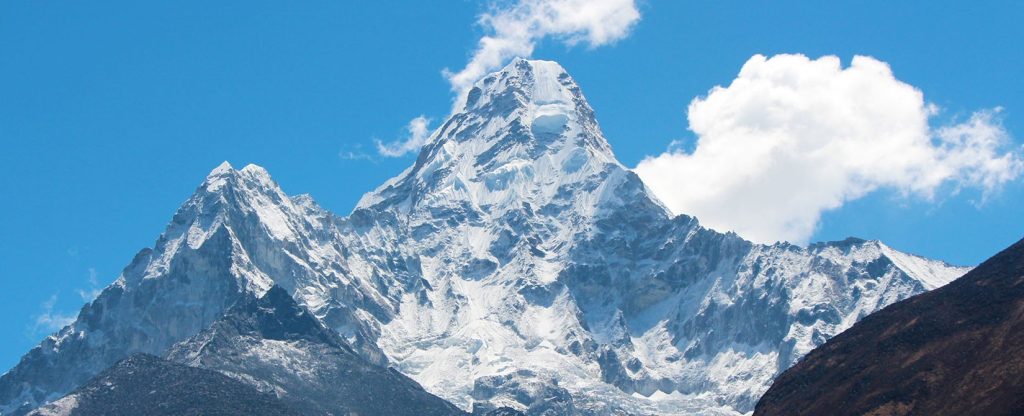
Trekking in Nepal in June June is part of Nepal’s short summer before the monsoon season occurs from the second to the third week of this month. You can expect the daytime temperatures to be hot below 1500 meters, warm up to 2500 meters, and warm/cool above 2500 meters. You can do most treks during June; choosing higher altitude treks for cooler temperatures is advised. This is ideal for the Upper Dolpo Circuit, Upper Dolpo Traverse, or Upper Mustang, as these regions are in the rain shadow. As always – it pays to invest in proper equipment such as a suitable down jacket (if you are trekking at a high altitude), sleeping bag, a couple of layers of fleece, right thermal underwear, thick hiking socks, gloves, trekking pants, warm hats to name a few necessary gears to invest in. It is always better to have more than less. It is good to dress up in layers, which you can ‘peel’ one at a time when you start to warm/heat up as you begin trekking. Benefits of Trekking in Nepal Himalaya during June. This is the spring season, and flowers bloom in the middle hills of Nepal. Rhododendron forests can be very colourful with white, pink, and crimson red (Nepal’s national flower) flowers in bloom, Magnolias and wild orchids, to name a few. However, the clouds can begin to form in the latter part of the day, and it can start raining at the lower altitude and snow in the higher elevations during the late afternoon or evening. This is a good thing as it can clear the clouds and clear the clouds for excellent mountain views the following day. There will still be fewer trekkers on the trail and lodges if you go trekking during February to the popular trekking areas where there are lodges. You will be warm to hot while hiking during the daytime. You could be the only trekker in the lodge. For the same reason, the wifi works better in the hostels as fewer people log in. You can use the internet better for weather forecasts and temperatures. There will be fewer people queuing for hot showers. The flowers will be blooming at altitudes above 4500 meters. Can I do a high-altitude trek in Nepal during June? You can undoubtedly do a high-altitude trek in Nepal during June. This is a better time to do a high-altitude trek than February or March. This is because we receive some monthly precipitation for a few days. We receive more massive snowfalls during February and March. Dangers/Inconveniences of trekking in Nepal during June. Most of the lodges should be open. Not all food on the menu will be available. There could be very windy conditions in the higher elevations, be prepared. The monsoon season might start while you are trekking. The leeches might start coming out below 2400 meters if it rains. It can be hot and humid in lower elevation areas. Insects in the lower altitude areas can bite you – bring suitable insecticide. June is still early, but the monsoon rains could disrupt domestic flights to or from Short take-off and landing strips (STOL) airports like Lukla, Jomsom, and Juphal. In addition, landslides can block roads causing delays in your holiday program (the 3rd week of June is an early monsoon, unlikely for landslides, but one never knows). June 2022 – There has been high rainfall even before the monsoon clouds hit Nepal. June 2021 – The monsoon took place on time, but it dumped a lot of rain from the 11th of June, causing huge floods and landslides and causing massive damage at the beginning of the monsoon season. Rainfall was 25 % heavier this year compared to the previous years. June 2020 – The first weekend of this month experienced rain in the low to middle hills and snow in higher elevations. It was caused by Cyclone Nisarga, which nearly missed Mumbai on the 3rd of June. The monsoon started on the 15th of June this year. The first three weeks of June 2019 experienced some pre-monsoon rain throughout Nepal. The monsoon was ‘late’ by about ten days and arrived on the 20th of June. The monsoon’s arrival was still weak until the end of the month. June 2018 received more rain than usual in the first two weeks, and there was very little precipitation for the second half when the monsoon should have started. Trekking regions that are in the Rainshadow areas: Upper Mustang Trek You will be visiting one of the scenic trekking trails in the monsoon season in Nepal. Once an independent Kingdom that was later annexed into Nepal’s territory, Upper Mustang is one of the restricted trekking destinations in Nepal that requires a special permit and to be booked with a tour operator. Back Packers are not allowed to trek here—the Buddhists who were once followers of the Bon religion inhabit the upper Mustang predominantly. Upper Mustang is a high-altitude desert. During the monsoon season, you will witness the rivers’ increased water levels, including the holy and mighty Kali Gandaki River. Upper Dolpo Trek This trekking destination takes you to one of the most remote regions in Nepal. The followers of the Bon religion, followed by Buddhists and Hindus, mainly inhabit it. The locals’ terrain, culture, and traditions are very close to the Tibetan way of life. The trekking trail partly lies in the Shey Phoksundo National Park, Nepal’s most extensive National Park. It is the only National Park in the trans-Himalaya region. The beauty of this region is unparalleled to other trekking destinations. Upper Dolpo doesn’t receive continuous rainfall in the rain shadow region. Trek here for the unique culture, landscape, scenery, and biodiversity. Jomsom to Muktinath Trek – email us for the itinerary. This trekking destination is more popular as a pilgrimage that is suitable during the monsoon season in Nepal. Muktinath attracts both Hindus and Buddhists alike for pilgrimage. Thus, you may embark on a spiritual or
Trekking in Nepal during May
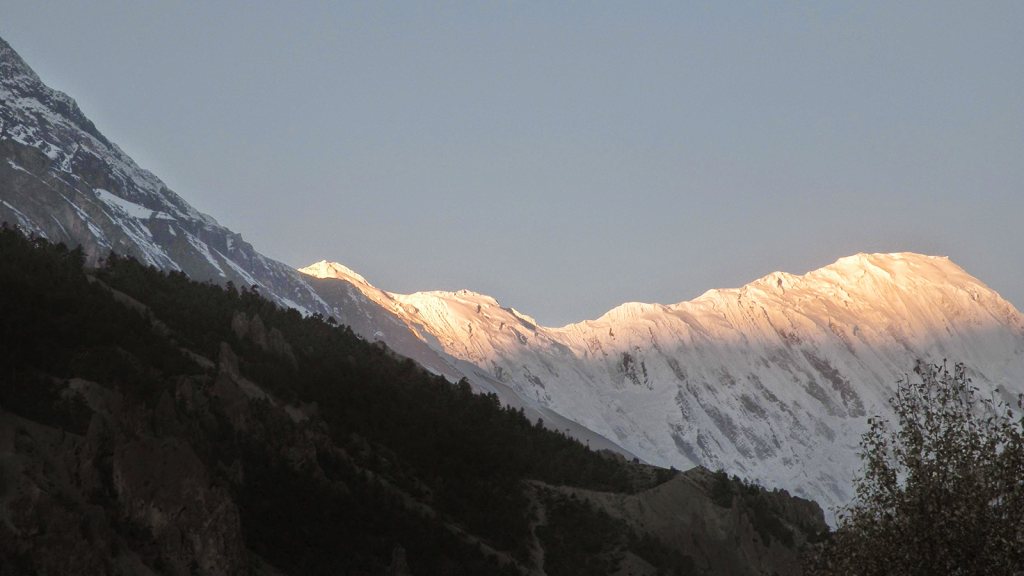
Trekking in Nepal in May May is the end of spring, and you can expect the weather to be hot in the lower elevations and warm at higher altitudes during the daytime. Despite some snowfall in the higher mountains than during May, it is much warmer, and the warmth helps to melt the snow quicker, making the trails wet, muddy, and slippery. Therefore, take precautions to hike safely. When you come across wet stones/rocks, green or black rocks/trail, muddy trail, or roots of trees in the forest – assume it is slippery and tread carefully. You should make most of the favourite trekking trails if you are an experienced hiker except for the less trodden treks such as Upper Dolpo Circuit or Upper Dolpo Traverse because deep snow will make it challenging to get through the passes that are above 5000 meters. As always – it pays to invest in proper equipment such as a suitable down jacket, sleeping bag, a couple of layers of fleece, right thermal underwear, thick hiking socks, gloves, trekking pants, and warm hats, to name a few essential gears to invest. It is always better to have more than less. It is good to dress up in layers that you can ‘peel’ one at a time when you start to warm/heat up as you begin trekking. Benefits of Trekking in Nepal Himalaya during May. May is the spring season’s end, and flowers bloom in Nepal’s middle hills. Rhododendron forests can be very colourful with white, pink, and crimson red (Nepal’s national flower) flowers in bloom, Magnolias and wild orchids, to name a few. However, the clouds can begin to form in the latter part of the day, and it can start raining at the lower altitude and snow in the higher elevations during the late afternoon or evening. This is a good thing as it can clear the clouds and clear the clouds for excellent mountain views the following day. The spring rain, hail, or snow can drop the Rhododendron petals and make the forest floors bright and colourful. All the lodges and restaurants will be open during the spring season. Lodges are unlikely to be packed. The food might be prepared faster due to fewer people staying at the lodge. Internet speed should be decent. You will be warm to hot while hiking in the sunny weather – perhaps you will sweat on the uphill climbs. You will get to meet many other trekkers in the lodges. All food on the menu will be available. The lodges will be fully stocked. Can I do a high-altitude trek in Nepal during May? You can undoubtedly do a high-altitude trek in Nepal during May. This is a better time to do a high-altitude trek than February or March. We do receive some precipitation for a few days every month. We receive more massive snowfalls during February and March rather than in the middle of May. Dangers/Inconveniences of trekking in Nepal during May The toilet floors could be wet and dirty due to the muddy trails. The paths could be icy or muddy due to the spring rain/snowfall. The trail could be slippery, and dirt can camouflage the ice. There could be very windy conditions in the higher elevations. You will likely face rain in the lower elevations and snow in the higher mountains during May. The views might not be as good in spring as it is during late autumn and May. In addition, forest fires could worsen the views during late spring. Trekking during May of 2021 (2nd wave in Nepal) and 2020 was disrupted due to the COVID-19 pandemic. May 2021: Nepal is experiencing good pre-monsoon thunderstorms for the first ten days. May 2020: Nepal experienced more precipitation than usual during the first week. There was lots of wind, thunder, lightning, hail, and rainstorms at the beginning of the month. The cyclone Amphan brought rain during the last week in Nepal and neighbouring countries. The visibility and environment were much cleaner and clearer due to the COVID-19 pandemic lockdown. Nepal received record snowfall in the higher altitude locations and rainfall during most of May 2019. The precipitation intensity lowered towards the third week, but some areas received rain and snowfall. May 2018 received more rainfall than the average caused by the Western disturbances and from the Bay of Bengal. The benefits of the showers provided much clearer days for those on the trekking trails.










